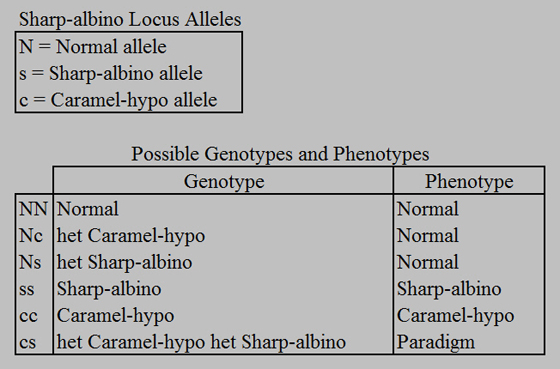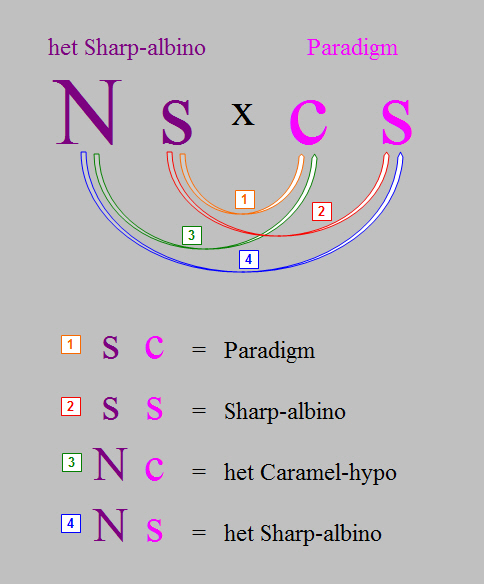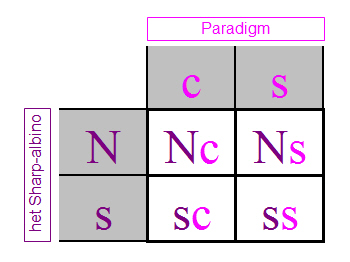|
Before further discussion, we will define a few more terms that will be helpful
along the way.
Codominance – two alleles
both affect the phenotype in separate, distinguishable ways.
Incomplete Dominance – the
phenotype of the heterozygote lies somewhere in between the phenotypes of the two associated homozygous forms.
Caramel-hypo – also known
as Sharon Moore Caramel or Boawoman‑hypo (and sometimes abbreviated BW-hypo or BW-Caramel), the allele for this form
of hypomelanism occurs at the Sharp-albino locus, is recessive to the normal allele, and exhibits incomplete dominance with
respect to the Sharp‑albino allele. Note that the Salmon‑hypo form
of hypomelanism is controlled by a different gene. Also note that there are three
known alleles that can occur at the Sharp-albino locus: normal, Sharp-albino
and Caramel-hypo.
These additional definitions will get us through our discussion of Paradigm
genetics and the three alleles involved at the Sharp-albino locus, but first we will look at a more familiar example of a
gene with three alleles – the gene for human blood type.
Multiple Alleles – A Familiar
Example
The ABO blood type in humans is determined by three alleles of a single gene. The letters A and B do not actually refer to alleles, but to two carbohydrates that
may be found on the surface of a person’s red blood cells. However, the
notation will be simpler if we use the letters A, B and O to represent the three alleles that can occur at this locus and
which code an enzyme to attach either the A carbohydrate (allele A), the B carbohydrate (allele B), or neither (allele O). There are six possible pairings of these three alleles at the locus, and four resultant
phenotypes (blood types). The A and B alleles are both completely dominant to
the O allele, but are codominant with respect to each other. Thus, people with
allele combinations AA or AO will be blood type A and will have the A carbohydrate on their red blood cells. Similarly, people with allele combinations BB or BO will be blood type B and will have the B carbohydrate
on their red blood cells. Recessive homozygotes, OO, will be blood type O and
their red blood cells will have neither the A nor the B carbohydrate. Finally,
people with the codominant AB allele combination will be blood type AB and will have both carbohydrates A and B on their red
blood cells.
The Spectrum of Dominance
Note in the above example of codominance that the phenotype AB is not intermediate
between the A and B phenotypes. Rather, both phenotypes A and B are exhibited
as both A and B carbohydrates are present on the red blood cells of the AB heterozygote.
Instances in which an intermediate form exists are cases of incomplete dominance,
such as when red‑flowered snapdragons are crossed with white‑flowered snapdragons producing pink‑flowered
heterozygotes.
The distinction between codominance and incomplete dominance is often not so
straightforward as in the above examples. Generally, it is more useful to consider
a spectrum of dominance in which alleles can show varying degrees of dominance and recessiveness in relation to each other,
and in which for any character the dominant/recessive relationship between alleles is dependent upon the scale at which phenotype
is examined.
For example, in a baby with Tay-Sachs disease, an inherited disorder in humans,
a specific dysfunctional enzyme leaves the brain cells unable to metabolize certain lipids that begin to accumulate. As these lipids accumulate in the brain cells, an affected infant will begin to exhibit
symptoms that may include seizures, blindness, and degeneration of motor skills and mental performance; the condition is fatal
within a few years.
Only children who are homozygous for the Tay-Sach’s allele have the disease,
and so at the organismal scale the Tay-Sach’s allele is recessive. However,
children who inherit only one copy of the Tay-Sach’s allele (heterozygotes) have been found to produce normal and dysfunctional
enzyme molecules in equal numbers, and so at the molecular level the normal and Tay-Sach’s alleles are codominant. Heterozygotes do not suffer from the disease, apparently because having half the normal
compliment of the functional enzyme is sufficient to prevent lipid accumulation in the brain cells. Finally, in heterozygotes the activity level of the lipid-metabolizing enzyme is intermediate between that
in individuals with Tay-Sach’s disease and those who are homozygous for the normal allele. This intermediate phenotype observed at the biochemical scale fits the definition of incomplete
dominance.
This example shows that whether an allele appears to exhibit complete dominance,
incomplete dominance, codominance or recessiveness with respect to another allele depends upon scale and which specific phenotypic
trait is considered.
Multiple Alleles – The Paradigm
Boa
Breeding trials completed by Mike Weitzman at Basically Boas between 2004 and
2006 suggested that there are not two, but three alleles that can appear at the
Sharp-albino locus: the normal allele, the Sharp‑albino allele, and the
Caramel‑hypo (a.k.a. Sharon Moore Caramel, Boawoman-hypo, BW-Caramel, or BW-hypo) allele. The normal allele is completely dominant with respect to both the Sharp‑albino and Caramel‑hypo
alleles (it is equivalent to say that the Sharp-Albino and Caramel‑hypo alleles are recessive with respect to the normal
allele). The Sharp‑albino and Caramel‑hypo alleles are incompletely
dominant with respect to each other. It is the combination of a Sharp‑albino
allele with a Caramel‑hypo allele at this locus that results in the Paradigm phenotype. The
Paradigm phenotype is an intermediate between the Caramel‑hypo and Sharp‑albino phenotypes. Note that one could just as easily argue that this is a case of codominance, with the Caramel-hypo and
Sharp-albino alleles both contributing to the overall appearance of the Paradigm boa in separate and distinct ways. Whichever terminology one prefers, it is clear that the combination of a Caramel-hypo allele with a Sharp-albino
allele at the Sharp-albino locus results in a distinct fourth phenotype (Paradigm) that is readily visually distinguishable
from the normal, Caramel-hypo, and Sharp-albino phenotypes. Additional breeding
trials completed in 2007 and 2008, including Paradigm-to-Paradigm, have served to further prove the relationships between
the three Sharp-albino locus alleles and their occurrence at that locus.
The possible allele combinations (genotypes) and the associated phenotypes
are summarized below.

We will now consider
a test cross that involves all three alleles: a Paradigm bred to a het Sharp‑albino. The analysis is performed in the same manner as the previous example of a Sharp‑albino
bred to a het Sharp‑albino.

As before, we can achieve the same results using the more compact notation
of the Punnett Square.

The expected offspring genotypes, phenotypes and frequencies are summarized
below.

It is easily seen from the summary above that, on average, half of
the offspring from this cross will be of the normal phenotype. Each of these
normal‑appearing offspring will be heterozygous for either Sharp‑albino or Caramel‑hypo, but there is no
way to tell which one until that boa is raised to maturity and bred to an appropriate mate.
Thus we find ourselves with a nomenclature problem. One might initially be tempted to call these boas “possible het Sharp-albino possible het Caramel-hypo,”
but this does not accurately describe the genetics in that these are not possible heterozygotes – they are
heterozygous for Sharp-albino or Caramel-hypo, but it cannot be determined which except through breeding trials. It quickly became clear that a new name would have to be chosen for these boas, because
it is most inconvenient to continually refer to them as “the ones that are heterozygous for either Sharp‑albino
or Caramel‑hypo but you can’t tell which until you grow them up and breed them.”
Sometime shortly after September, 2006 when Mike Weitzman had first publicly
announced the arrival of the Paradigm boa and the associated genetics, I discussed this nomenclature issue with him and found
that he had already been struggling with it for some time, “I gotta find something to call these things….!” Being the originator of the Paradigm morph, it was clearly Mike’s right
to choose the name for these “het for Sharp or Caramel but can’t tell which etc. etc.” boas. I was quite honored when, after a number of rejects, Mike selected one of the possible names that I had
suggested – and so the ParaHet was born.
Very simply, a ParaHet is heterozygous for either Sharp‑albino or Caramel‑hypo, but which it is cannot
be determined except through breeding trials. Using the ParaHet name allows us
to revise and simplify the summary of expected offspring as shown below.

So we have the ParaHet. We know
it is heterozygous for one of two things, but we don’t know which….what the heck good is that?! As it turns out, it is a surprisingly good thing.
Continue to "3. The ParaHet"
Back to "1. Basic Genetics Refresher"
Back to the "Genetics and Paradigms" Page
|

